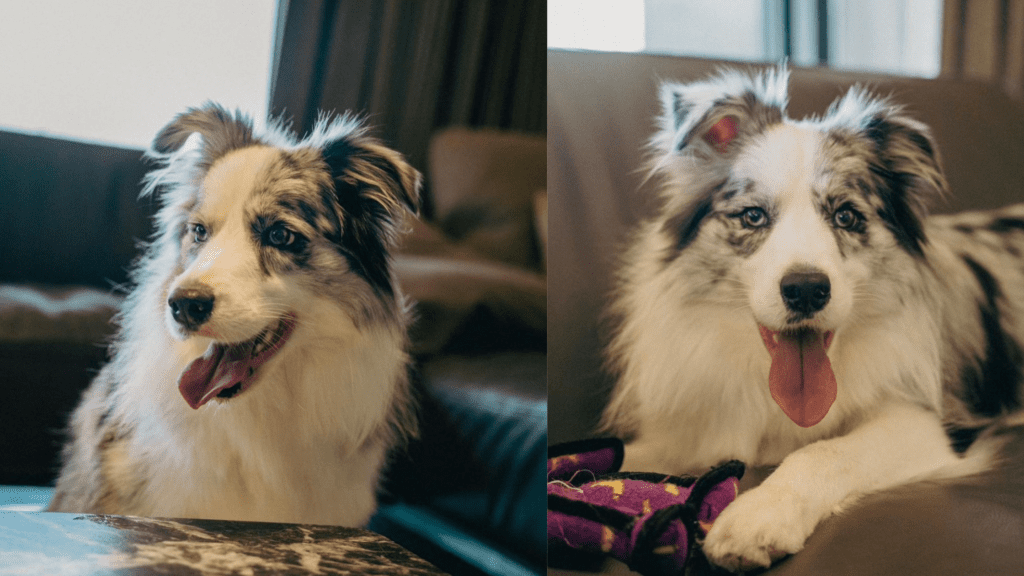The Border Collie Blue Merle is a striking variation of the beloved breed, featuring a captivating merle coat pattern. This unique pattern is not a color but a genetic variation that creates a speckled or mottled appearance on the coat. While the merle pattern has been present in several dog breeds for many years, it was officially recognized and named in the early 2000s. Also referred to as the “dapple” pattern, it can be found in various breeds, such as Australian Shepherds, Welsh Cardigans, Great Danes, Dachshunds, and Shetland Shepherds.
The merle pattern can take on a range of shades, from dark, irregular patches to dots or stripes on a dilute or lighter shade of the base coat. That creates a mesmerizing and ever-changing appearance that is sure to turn heads. The Border Collie Blue Merle is a true beauty, both in looks and spirit.
Border Collie Blue Merle Litter and Genetics
Genetics can be hard to understand, but it’s like a secret code that makes a dog look a certain way. Every dog gets two codes from their parents, one for the primary color and one for a unique pattern.
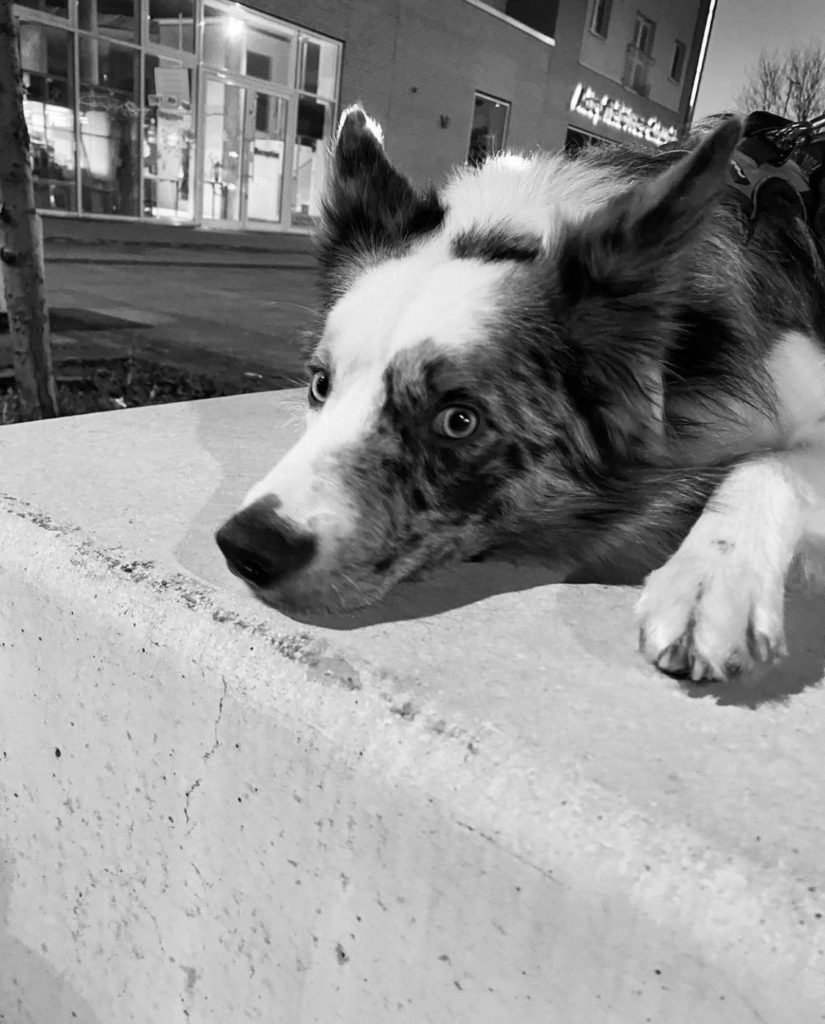
For a Border Collie to have a Blue Merle coat, one of its parents must have a unique code for the Blue Merle pattern. To generate the Blue Merle coat with spots and lines, the breeder lightens the primary color code, like black.
Even if both parents are Blue Merle, not all the puppies in the litter will have the same coat. Some puppies might have the Blue Merle coat, while others might not.
There is also a particular type of Blue Merle called Cryptic Merle or Ghost Merle. These dogs look primarily black but have some small areas of Blue Merle.
Even though these dogs are pretty, the breeder must follow good rules and ethics when breeding them.
What makes a Blue Merle Border Collie stand out in coat color and pattern?
A Blue Merle Border Collie stands out in coat color and pattern due to its unique merle coloration. The merle gene makes the coat mottled or speckled with blue, gray, black, brown, or red. The coat may also have a marbled or mottled look, with the merle pattern appearing in random, irregular spots. A dilution of the coat’s black or brown pigments causes the color blue or gray. This uncommon coloration defines the Blue Merle Border Collie from other Border Collies.
Female Size
The size of a Border Collie Blue Merle can vary. Female ones are smaller than male ones. They are usually around 18-22 inches tall and weigh between 30-55 pounds.
Due to their high energy levels, they are not suitable for living in cramped quarters. In a farm or ranch, they can herd animals and assist with tasks. A big house with an expansive and secure yard would also work well for them.
The Merle pattern can also affect other physical features of the dog, not just the color of the coat.
Do Blue Merle Border Collies have blue eyes?
Yes, Blue Merle Border Collies can have blue eyes. The merle gene not only changes the color of their coat, but it can also change the color of their eyes.
A Blue Merle Border Collie can have eyes that are amber, pale green, or pale blue. These colors make their eyes look extra special and unique. Some people might think their eyes are brown or blue, but they can also have a mix of both colors. Sometimes, Blue Merle Border Collies have eyes of different colors, called heterochromia. That means one eye is brown, and the other is blue.
Blue Merle Border Collies have many variations, and their eye colors can be unique and different. Some have one blue eye, and the other is a mix of brown and blue.
In summary, Blue Merle Border Collies can have blue eyes, which can be pale blue, pale green, or amber. Some of them might have heterochromia; one watch could be blue, and the other could be brown and blue.
You May Also Interest: Can dogs sense negative energy?
Border Collie Blue Merle Temperament and Characteristics
Like all purebred Border Collies, Blue Merle Border Collies have the same personality and characteristics. Their coat color does not change how they behave or act.
Blue Merle Border Collies are intelligent, active, athletic, and energetic. They love to please their owners and make great family pets.
Some health problems may be associated with the merle gene, but it does not affect a dog’s personality.
Even though Blue Merle Border Collies are beautiful, what makes them unique is their natural ability to herd and their intelligence. That is what they were bred for, and it’s in their nature.
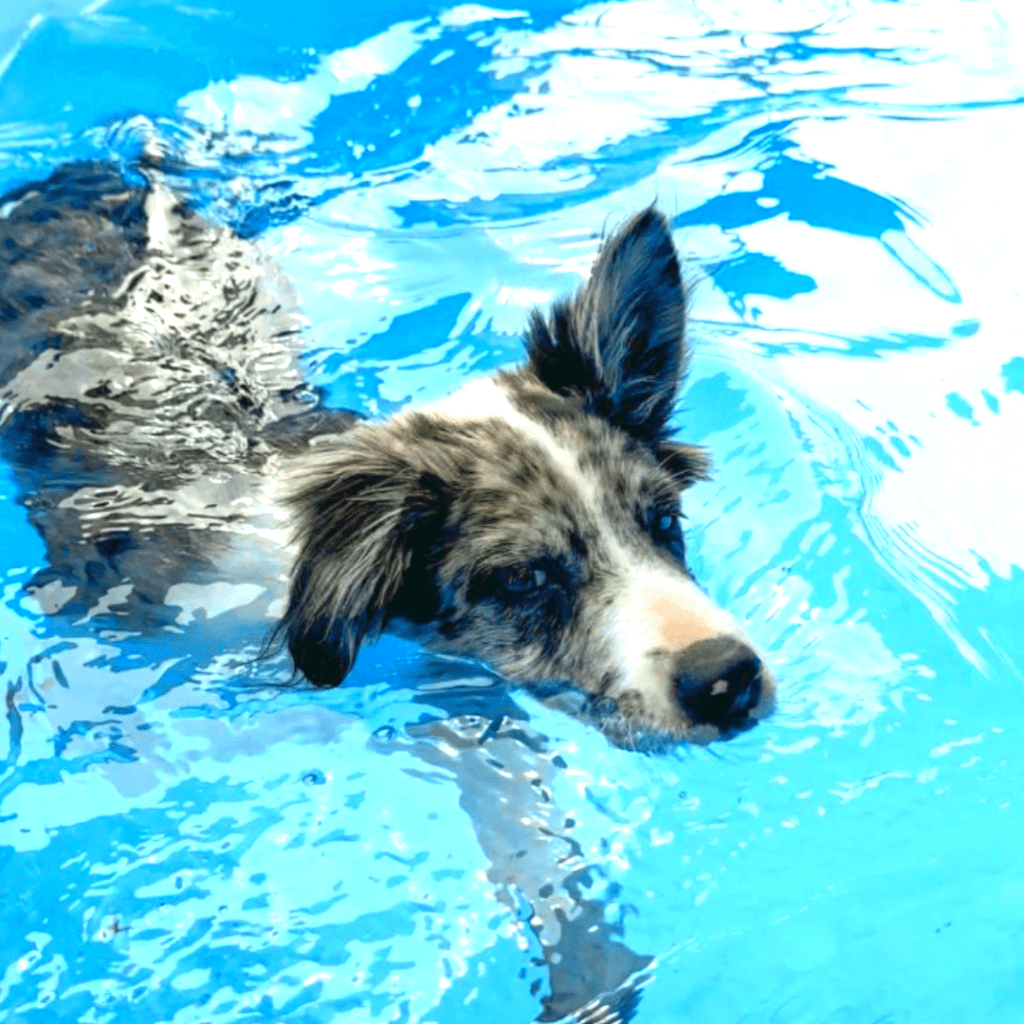
How do you take care of a Blue Merle Border Collie?
Taking care of a Border Collie Blue Merle is similar to taking care of any other Border Collie. They have double-coated fur that helps protect them from hot and cold weather, but they will shed, especially during the winter.
You should brush their coat twice a week, but during the winter, you should brush it every day. Light-colored skin can be prone to getting dirty or stained. So, it would be best to bathe them every three months or as needed.
Clean their ears once a week with a cloth or cotton ball to prevent wax and debris buildup and remove excess moisture. To keep their nails healthy, you should trim them every two to three weeks.
You May Also Interest: Unleashing the Unique Beauty of Long Haired Merle Dachshunds
Diet and exercise:
To ensure your Border Collie Blue Merle is healthy and happy, you need to give them the right amount of food and exercise. The food they need will depend on their size, age, and how active they are.
Border Collies need more calories to stay energetic due to their medium stature. Active Border Collie Blue Merles may need 900–1,000 calories per day. Working dogs and herders need 1,400 calories every day.
For exercise, your Border Collie Blue Merle should get at least one hour daily. That can include walking, running, hiking, or other types of exercise or training. These activities will help them stay healthy and have good behavior.
Health/genetic problems
The merle pattern gene is not only complicated but it is also associated with potential health problems. All dogs are usually healthy when bred and treated correctly but can still be prone to genetic health problems. Some common diseases in Border Collies are epilepsy, hip dysplasia, Collie eye anomaly (CEA), and progressive retinal atrophy (PRA).
If you decide to get a Border Collie Blue Merle, you should know that this pet can contract other diseases related to coat color.
The term “death white” refers to dogs with double-merle genotypes. The two parent breeds that carry the merle gene have a 25% chance of producing a double merle Border Collie dog. On average, this equates to one-quarter of the litter.
The merle gene acts as a “bleaching agent,” There is too much white in double merles. They usually have white heads and ears. Hearing and visual defects may occur in this type of breed.
The Spanish Border Collie Association has indicated that hereditary or congenital deafness has many causes. But those with merle, piebald and roan coats, blue eyes, or white heads have a significantly higher risk of hearing problems.
We can prevent the passage of the double merle gene by quickly sterilizing dogs with the color pattern.
Border Collie Blue Merles live 12 years. 10–14 years. Others live 17 years longer!
In the case of blind or deaf blackbirds, they must get used to their situation and be careful, but this impossibility does not affect the pets’ mood, as they tend to be affectionate.
You May Also Interest: Discover the Beauty of the Rare Merle Great Dane
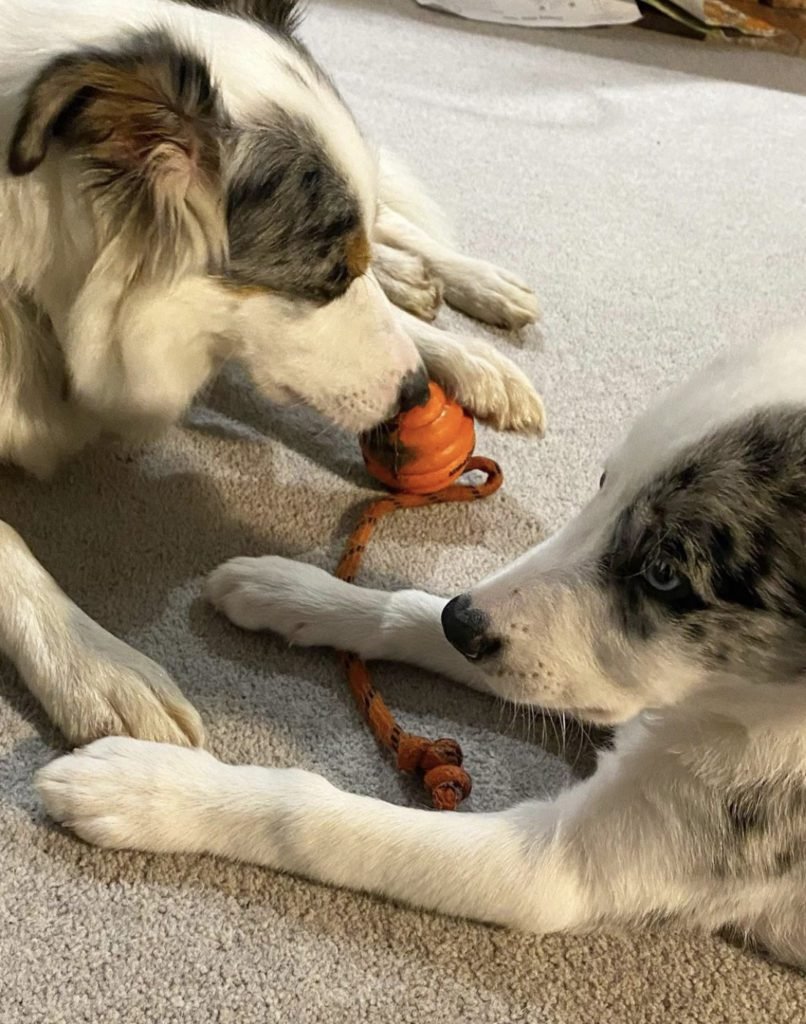
Border collie blue merle Cost
The Border Collie Blue Merle is a beautiful and rare breed of dog known for its striking coat color and pattern. The merle gene, which causes the mottled appearance, is recessive and can only be passed on if both parents carry it. That makes the Blue Merle Border Collie a rare find, and as a result, its cost can vary significantly depending on the location and pedigree of the dog.
While the average price for a Border Collie is around $800, prospective owners should be prone to pay slightly more for a Blue Merle. However, it’s important to note that the cost should not be the only factor considered when purchasing or adopting a dog. Prospective owners should also take into account the health history of the dog, as well as the living conditions provided by the breeder.
It’s essential to ensure that the breeder has the dog’s best interests and that the animal raises in a healthy environment. Some breeders may take advantage of the rarity of the Blue Merle Border Collie and charge exorbitant prices, but future owners must remember that a higher price tag does not guarantee a better dog.
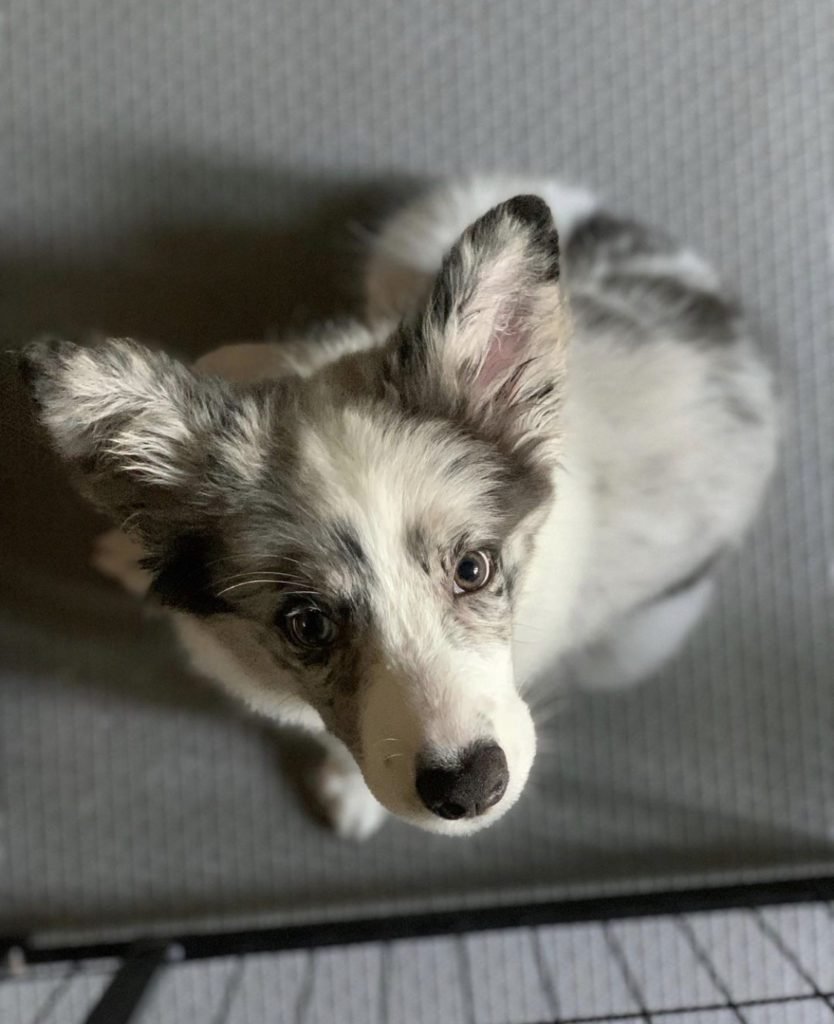
Should I buy a Border Collie Blue Merle?
Many professional experts in canine behavior and genetics confidently say that the Border Collie Blue Merle is a unique and highly sought-after breed. With their striking blue and black coat pattern and undeniable intelligence and trainability, these dogs are truly one-of-a-kind.
However, it is essential to note that the merle gene, which causes the blue and black coat pattern, is also associated with potential health problems. Blue Merle Border Collies may be more prone to eye defects and congenital deafness, so it’s crucial for potential owners to be aware of these risks and to seek out reputable breeders who prioritize the health of their dogs.
But despite these potential health concerns, the Border Collie Blue Merle is an excellent family pet. They are highly social and thrive in homes with plenty of human interaction and activity. They excel in various dog sports such as agility, obedience, and flyball, making them ideal companions for active, outdoorsy families.
When considering a Border Collie Blue Merle, it’s important to remember that they require consistent training, socialization, and exercise to thrive. They also have a strong herding instinct, so they must be aware of their behavior around children and other pets.
The Border Collie Blue Merle is a unique and highly rewarding breed. They can make an excellent companion for the right family with proper care and training. However, it’s essential to be aware of the potential health concerns and seek a reputable breeder who prioritizes the health and well-being of their dogs.

